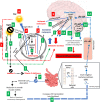Latitude, Vitamin D, Melatonin, and Gut Microbiota Act in Concert to Initiate Multiple Sclerosis: A New Mechanistic Pathway
- PMID: 30459766
- PMCID: PMC6232868
- DOI: 10.3389/fimmu.2018.02484
Latitude, Vitamin D, Melatonin, and Gut Microbiota Act in Concert to Initiate Multiple Sclerosis: A New Mechanistic Pathway
Abstract
Multiple sclerosis (MS) is an inflammatory demyelinating disease of the central nervous system (CNS). While the etiology of MS is still largely unknown, scientists believe that the interaction of several endogenous and exogenous factors may be involved in this disease. Epidemiologists have seen an increased prevalence of MS in countries at high latitudes, where the sunlight is limited and where the populations have vitamin D deficiency and high melatonin levels. Although the functions and synthesis of vitamin D and melatonin are contrary to each other, both are involved in the immune system. While melatonin synthesis is affected by light, vitamin D deficiency may be involved in melatonin secretion. On the other hand, vitamin D deficiency reduces intestinal calcium absorption leading to gut stasis and subsequently increasing gut permeability. The latter allows gut microbiota to transfer more endotoxins such as lipopolysaccharides (LPS) into the blood. LPS stimulates the production of inflammatory cytokines within the CNS, especially the pineal gland. This review summarizes the current findings on the correlation between latitude, sunlight and vitamin D, and details their effects on intestinal calcium absorption, gut microbiota and neuroinflammatory mediators in MS. We also propose a new mechanistic pathway for the initiation of MS.
Keywords: gut microbiota; latitude; melatonin; multiple sclerosis; sunlight; vitamin D.
Figures

Similar articles
-
Multiple Sclerosis: Melatonin, Orexin, and Ceramide Interact with Platelet Activation Coagulation Factors and Gut-Microbiome-Derived Butyrate in the Circadian Dysregulation of Mitochondria in Glia and Immune Cells.Int J Mol Sci. 2019 Nov 5;20(21):5500. doi: 10.3390/ijms20215500. Int J Mol Sci. 2019. PMID: 31694154 Free PMC article. Review.
-
Melatonin and vitamin D, two sides of the same coin, better to land on its edge to improve multiple sclerosis.Proc Natl Acad Sci U S A. 2023 Apr 4;120(14):e2219334120. doi: 10.1073/pnas.2219334120. Epub 2023 Mar 27. Proc Natl Acad Sci U S A. 2023. PMID: 36972442 Free PMC article. Review.
-
Multiple Sclerosis, Gut Microbiota and Permeability: Role of Tryptophan Catabolites, Depression and the Driving Down of Local Melatonin.Curr Pharm Des. 2016;22(40):6134-6141. doi: 10.2174/1381612822666160915160520. Curr Pharm Des. 2016. PMID: 27634184 Review.
-
New hypotheses on sunlight and the geographic variability of multiple sclerosis prevalence.J Neurol Sci. 2010 May 15;292(1-2):5-10. doi: 10.1016/j.jns.2010.02.004. Epub 2010 Mar 1. J Neurol Sci. 2010. PMID: 20189603 Review.
-
Multiple sclerosis: sunlight, diet, immunology and aetiology.Med Hypotheses. 1996 Feb;46(2):67-74. doi: 10.1016/s0306-9877(96)90002-x. Med Hypotheses. 1996. PMID: 8692046
Cited by
-
Multiple Sclerosis: Melatonin, Orexin, and Ceramide Interact with Platelet Activation Coagulation Factors and Gut-Microbiome-Derived Butyrate in the Circadian Dysregulation of Mitochondria in Glia and Immune Cells.Int J Mol Sci. 2019 Nov 5;20(21):5500. doi: 10.3390/ijms20215500. Int J Mol Sci. 2019. PMID: 31694154 Free PMC article. Review.
-
Vitamin D as a Risk Factor for Multiple Sclerosis: Immunoregulatory or Neuroprotective?Front Neurol. 2022 May 16;13:796933. doi: 10.3389/fneur.2022.796933. eCollection 2022. Front Neurol. 2022. PMID: 35651353 Free PMC article. Review.
-
A Novel Role of Nogo Proteins: Regulating Macrophages in Inflammatory Disease.Cell Mol Neurobiol. 2022 Nov;42(8):2439-2448. doi: 10.1007/s10571-021-01124-0. Epub 2021 Jul 5. Cell Mol Neurobiol. 2022. PMID: 34224050 Free PMC article. Review.
-
Melatonin and multiple sclerosis: antioxidant, anti-inflammatory and immunomodulator mechanism of action.Inflammopharmacology. 2022 Oct;30(5):1569-1596. doi: 10.1007/s10787-022-01011-0. Epub 2022 Jun 5. Inflammopharmacology. 2022. PMID: 35665873 Free PMC article. Review.
-
The Role of the Status of Selected Micronutrients in Shaping the Immune Function.Endocr Metab Immune Disord Drug Targets. 2019;19(8):1100-1115. doi: 10.2174/1871530319666190529101816. Endocr Metab Immune Disord Drug Targets. 2019. PMID: 31142256 Free PMC article. Review.
References
Publication types
MeSH terms
Substances
LinkOut - more resources
Full Text Sources
Medical

